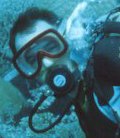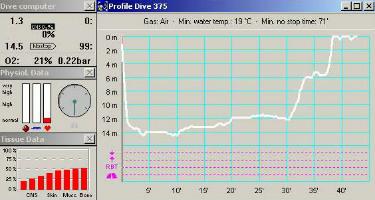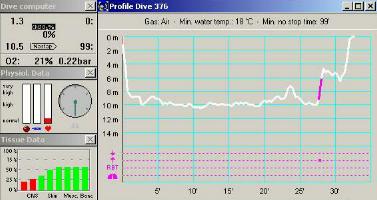Main Homepage: http://www.vancestevens.com
This site has a NetWord: http://www.netword.com/*scubavance
More Scuba: Back to Vance's Scuba Page | Return to Vance's Logbook contents
Navigate logbook: previous dive | next dive
![]()
Main Homepage:
http://www.vancestevens.com
This
site has a NetWord: http://www.netword.com/*scubavance
More
Scuba: Back to Vance's Scuba Page |
Return to Vance's Logbook contents
Navigate
logbook: previous dive | next
dive
 |
Dive Logs for Vance Stevens PADI open water scuba instructor #64181 Dive 378-379 February 1, 2001 Abu Dhabi, Delta Buoy and Old Cement Barge |
Diving
with:ADSAC
Dive sites: Delta Buoy and Old Cement Barge
Dive buddy: Mark Kindermann
Others in dive party: Pete Hardy,
Alan Smith, Brian King; Ron and Luis on assessment
Conditions: cool
with a mild swell; beat-back affect prevented us from reaching Hanan (3 hours
on GPS)
Water Temp: 19 and 18 degrees C on dive computer
Visibility: poor, 3 meters
Wetsuit combo: typhoon top and
farmer john inside
Weight: 8 kg.
Diving from: Pearl
diver
Training conducted: PADI Open Water advanced multilevel and boat dives for Mark Kindermann; certification achieved
Dive 378 Delta Buoy
Data from dive computer:
Time started down: 9:23 on my dive computer (9:25 on Mark's and my
watches)
Max depth: 14.5 meters
Time started up from chart: 31
minutes
Dive time from computer: 00:37
Min Temp: 19 degrees C
(chilly)
Nitrox 21% (normal air), no deco
PSI/Bar in: 200
PSI/Bar out: 75
Pressure group out, from wheel:
E

Description of dive:
This was Mark Kindermann's Advanced Open Water multilevel dive. We had originally planned to dive the Hannan, so Mark calculated a 20 meter dive with a 12 meter stop at the top of the mast as we were pulling out over the smooth water inside the harbor entrance. Out in the seas, there was a swell that wasn't so bad for travel as we were having to beat against it, so that by 8:30 we were only at Delta Buoy, still within sight to the city. We decided to call it a boat ride and dive there, and so Mark recalculated a 16 meter bottom level at 70 some-odd minutes NDL with a multilevel limit of another 70 some-odd at 12 meters top level. Brian, buddyless, decided to tag along.
The dive was executed perfectly, Mark in charge of keeping track of depth and time. We dropped down 14 meters onto the drab morass of the D-Buoy coral fields with little light, poor vis, and a pervasive chill. We let ourselves drift a little northeast with the current but after we'd been carried over a particularly barren spot, Brian signalled us to the northeast, so we finned into it (must ask him why he wanted to go that way). There were some nice big grouper around and some colorful grunts and angelfish. Brian steered us to the south east, toward the buoy (whose chains we could hear clanking through the water). After 19 minutes we came onto a 12 meter shelf with pleasant enough coral, and decided to stay in that area (Mark was aware of the depth; could have gone deeper, but then would have to have counted the entire time at the greater depth and signalled an awareness of later regaining 12 meters; as it was we stayed leveled off at 12 meters the remainder of the dive). I saw a ray buried in the sand, or rather I saw its tail out one end and its pointed snout at the other. We all passed near it and over it but it wanted to remain hidden so we didn't disturb it.
Mark was having a bit of leakage from his reg, steady stream of bubbles even when not inhaling, and at 30 minutes he held up 7 fingers indicating 70 bar remaining. A minute later we were ascending to our 3 minute 5 meter stop. Myself, I got myself neutrally buoyant at that point and breathed and exhaled while chasing the numbers on my computer. The chart above reveals that I was a bit low for most of the time. Mark did fine on his hover, remaining at correct 5-meter depth 3 minutes without tactile or visual reference, a challenge for any diver. On surfacing, the boat, which was not at anchor, collected us, as we had planned to meander at the whim of interest (if any) and current. However, back on the boat, Brian asked Mark if he knew which direction we'd been heading, and Mark's answer indicated that he had been aware of his whereabouts during the dive.
Surface Interval: 1:06
Pressure group in: C
Dive 379 Old Cement Barge
Data from dive computer:
Time started down: 11:12 on my dive computer
Max depth: 10.5
meters
Time started up from chart: 28 minutes
Dive time from
computer: 00:31
Min Temp: 18 degrees C (friggin cold)
Nitrox 21% (normal
air), no deco
PSI/Bar in: 200
PSI/Bar out: 90
Pressure group out, from
tables: Mark to calculate it

Description of dive:
This was Mark Kindermann's Advanced Open Water boat dive, and final dive for PADI Advanced Open Water certification.
The ADSAC lads were planning to dive the OCB for training next week and were going there to be sure they could locate the site. They discussed transits, the ones they used being a water tower at the end of a certain storage shed on the port side, and a tree at the edge of a park in town being lined up right on a gap or white strip in a certain building in town. They found the site on GPS (my two points for the OCB were 30 meters and 80 meters from where we drifted at the end of our anchor line). The anchor was dropped immediately on getting an indication on the fish finder and landed just off the south end of the wreck (the stern I believe). After Mark and I had come up from our dive, and on verifying that the anchor still lay right off the stern, they pulled the boat directly over its anchor and GPS'd that spot.
Alan and Luis had not dived at Delta Buoy due to extreme cold and lack of interest, but they had kitted up and went straight into the water for Luis's assessment once we'd anchored. They dragged a float over to the wreck and tied it there so Mark and I would know where to find it in relation to the anchor line (so once at the anchor, we knew to look northeast for the wreck). Mark and I were the only ones in the water besides Alan and Luis, Ron, Brian, and Pete all opting to spell each other on vigilant boat cover.
Mark didn't really want to do the dive either if he'd already done all his dives for advanced certification, but he hadn't, so we braved it. It was easer on me since I had a double layer of wetsuit on my core body parts. Down on the wreck we circled it twice. First time I combed the barnacles and clams packing the side for nudibranchs but didn't see any. Second time I swept wide into the sand looking for rays and for the Land Rover that used to be there (and which the guys said later the police had 'nicked'; which was why we didn't see one of the two things we were looking for in vain on those passes). Returning to the stern second time round we went over the hull into the innards and looked again in vain for anything of interest on the inside of the wreck, and the chart from 20-25 minutes shows the depths of the various parts of the wreck including the stacks of cement piled near the bow at 7 meters. Coming down on the bow wreckage we made one last pass along the outside toward the stern, regained the anchor line which we ascended on, gripping it at 5 meters to do our safety stop (required skill for advanced boat dive). However we noticed our handhold on the line changed depth as we swung up on it with the current, and as the chart shows, we found it difficult to adjust properly with a moving tactile reference. We were also joined at that point by a school of bat fish that enthralled me but had an unsettling affect on Mark. The cold and beguiling proximity of the circling fish gave Mark the first ever case that I have seen of batfish vertigo, so he thumbed me up at the tick of three minutes and had an upchuck on the surface while wondering how one goes about handling such situations through a reg at depth or while on deco stop. I guess the answer is, enigmatically, that when the time comes, necessity is the mother of invention.
Vance Stevens, vstevens@emirates.net.ae |
http://www.vancestevens.com/
Page
updated March 23, 2001 in Hot Metal Pro 6.0